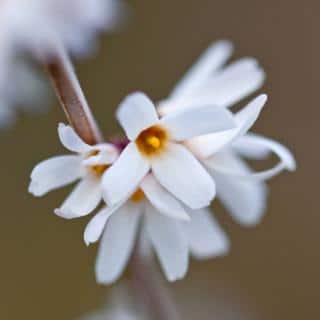

Korean forsythia looks just like yellow forsythia – but white.
White forsythia facts
Name – Abeliophyllum distichum
Family – Oleaceae
Type – shrubby bush
Height – 3 to 6 ½ feet (1 to 2 meters)
Exposure – full sun and part sun
Soil – ordinary, not too chalky
Foliage: deciduous – Flowering: spring – Hardiness: −50 °F (−46 °C)
Even though it bears the same name as yellow forsythia, it isn’t the same species. Flowers are nearly identical, and it brings a touch of creamy white to your garden, balcony or terrace.
This shrub is best planted right at the beginning of fall or in spring, but avoid at all costs days of freezing or very hot weather.
Even though it is reputed to be hardy (it resists to the coldest temperatures in Western Europe), root development will be at its best and settling in will be optimized.
It is also possible to grow white forsythia in a pot on a terrace or balcony, but provide for repotting every 2 or 3 years.
Korean white forsythia doesn’t really suffer from pruning and even should be pruned yearly in March to bloom better year after year.
Cut it back as much as you wish, trying to keep the shape as appealing as you can.
Native to Korea, white forsythia offers magnificent blooming at the end of winter or at the beginning of spring, towards February-March.

The flowers are rather short-lived, but they are simply remarkable, and their early blooming is like a preview of your magnificent gardens-to-be…
Its small size makes it the ideal shrub for low-lying hedges.
White forsythia is often planted as a standalone, but also appears in groups, flower beds or flowered hedges.
Read also:
In winter, mulch can be spread around the base of your white forsythia to protect roots from the cold, avoid weed growth and provide soil with the organic matter it needs.
It also brings blooming forward by a few days.